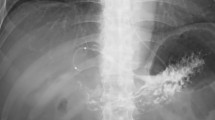Abstract
Fever, abdominal pain, and liver dysfunction are almost inevitable complications of transcatheter arterial chemo embolization (TACE) for hepatocellular carcinoma, but these symptoms may also be due to bile duct obstruction caused by shedding of necrotic tumor material into the bile duct. A 68-year-old man presented with persistent fever, liver dysfunction, and abdominal pain after TACE. Computed tomography revealed stone-like hyperdensities in the bile duct. Endoscopic retrograde cholangiopancreatography revealed these structures to be necrotic material from hepatocellular carcinoma. We believe this is an instructive case of an often overlooked situation.





Similar content being viewed by others
References
Llovet JM, Real MI, Montaña X, et al. Arterial embolisation or chemoembolisation versus symptomatic treatment in patients with unresectable hepatocellular carcinoma: a randomised controlled trial. Lancet. 2002;359:1734–9.
Lo CM, Ngan H, Tso WK, et al. Randomized controlled trial of transarterial lipiodol chemoembolization for unresectable hepatocellular carcinoma. Hepatology. 2002;35:1164–71.
Takayasu K, Arii S, Ikai I, et al. Prospective cohort study of transarterial chemoembolization for unresectable hepatocellular carcinoma in 8510 patients. Gastroenterology. 2006;131:461–9.
Takaki S, Sakaguchi H, Anai H, et al. Long-term outcome of transcatheter subsegmental and segmental arterial chemoemobolization using lipiodol for hepatocellular carcinoma. Cardiovasc Intervent Radiol. 2012;35:544–54.
Hiraki T, Sakurai J, Gobara H, et al. Sloughing of intraductal tumor thrombus of hepatocellular carcinoma after transcatheter chemoembolization causing obstructive jaundice and acute pancreatitis. J Vasc Interv Radiol. 2006;17:583–5.
Okuda M, Miyayama S, Yamashiro M, et al. Sloughing of intraductal tumor thrombus of hepatocellular carcinoma after transcatheter arterial chemoembolization. Cardiovasc Intervent Radiol. 2010;33:619–23.
Park HC, Park HB, Chung CY, et al. Acute obstructive cholangitis complicated by tumor migration after transarterial chemoembolization: a case report and literature review. Korean J Gastroenterol Taehan Sohwagi Hakhoe Chi. 2014;63:171–5.
Kim GM, Kim HC, Hur S, Lee M, Jae HJ, Chung JW. Sloughing of biliary tumour ingrowth of hepatocellular carcinoma after chemoembolization. Eur Radiol. 2016;26:1760–5.
Miyayama S, Yamashiro M, Nagai K, et al. Excretion of necrotic hepatocellular carcinoma tissues into the biliary system after transcatheter arterial chemoembolization. Hepatol Res. 2017;47:1390–6.
Meeralam Y, Al-Shammari K, Yaghoobi M. Diagnostic accuracy of EUS compared with MRCP in detecting choledocholithiasis: a meta-analysis of diagnostic test accuracy in head-to-head studies. Gastrointest Endosc. 2017;86:986–93.
Spahr L, Frossard JL, Felley C, Brundler MA, Majno PE, Hadengue A. Biliary migration of hepatocellular carcinoma fragment after transcatheter arterial chemoembolization therapy. Eur J Gastroenterol Hepatol. 2000;12:243–4.
Author information
Authors and Affiliations
Contributions
All authors have participated in writing, revising, and editing this manuscript.
Corresponding author
Ethics declarations
Conflicts of interest
The authors declare that they have no conflicts of interest in relation to this manuscript.
Informed consent
Informed consent was obtained from the patient for the publication of his information and imaging.
Additional information
Publisher's Note
Springer Nature remains neutral with regard to jurisdictional claims in published maps and institutional affiliations.
Rights and permissions
Springer Nature or its licensor (e.g. a society or other partner) holds exclusive rights to this article under a publishing agreement with the author(s) or other rightsholder(s); author self-archiving of the accepted manuscript version of this article is solely governed by the terms of such publishing agreement and applicable law.
About this article
Cite this article
Kobori, I., Masaoka, R., Maeda, H. et al. Post-embolization syndrome-like symptoms due to shedding of necrotic material of hepatocellular carcinoma into the bile duct following transcatheter arterial chemoembolization: an instructive case. Clin J Gastroenterol 17, 563–566 (2024). https://doi.org/10.1007/s12328-024-01932-z
Received:
Accepted:
Published:
Issue Date:
DOI: https://doi.org/10.1007/s12328-024-01932-z




